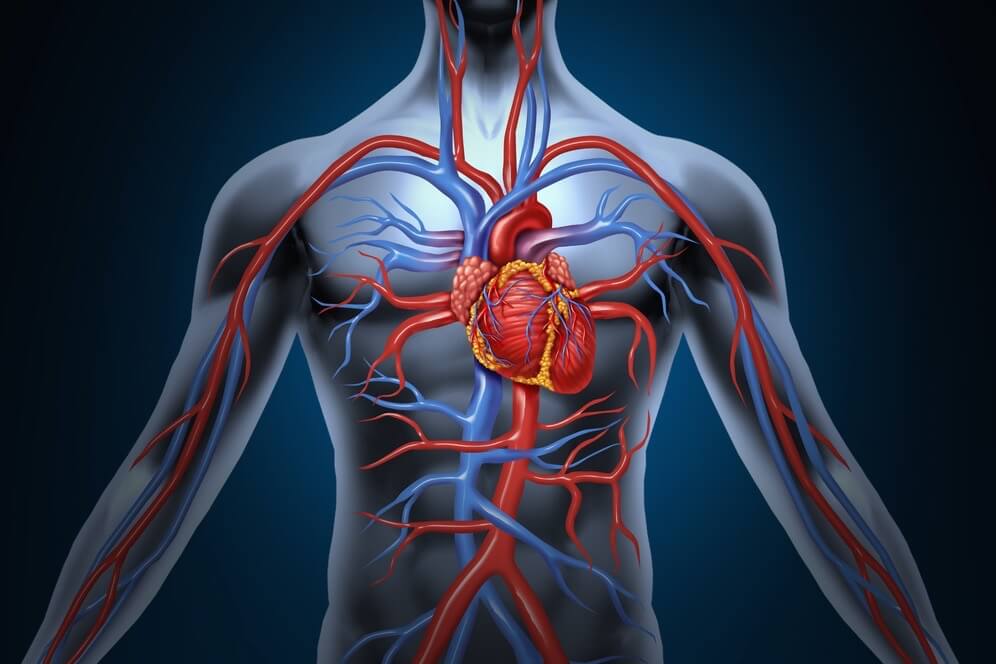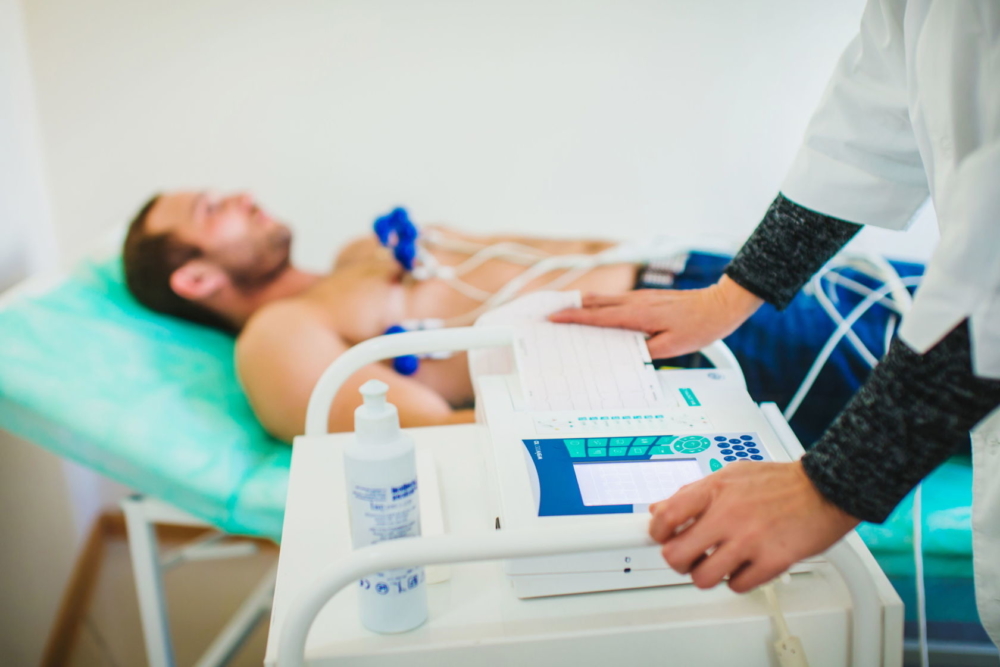Atrioventricular block is a pathology of impulse blocking between the atria and ventricles, leading to a violation of the heart rhythm and hemodynamics. The conduction system of the heart has the independence to generate impulses to reduce the myocardium.
Material Content:
Causes of AB blockade
Between the atria and the ventricles is the atrioventricular node, representing the concentration of a certain type of cell. They receive impulses from the atria, which, delaying for a very short time, spread further to the ventricles. With AVB, it slows down for longer or is completely absent, which leads to hypoxia of tissues and organs with the subsequent development of clinical symptoms.
According to the etiological factor, the following atrioventricular blockades are distinguished:
- functional AVB - their development is provoked by an increased influence of the autonomic nervous system, in particular, the vagus nerve. This condition can develop in people who are professionally involved in sports. Enhanced physical activity leads to hypertrophy of the walls of the heart, entailing changes in the volume of its chambers and, as a result, slowing down the passage of the pulse. This form of AV blockade is not beyond the scope of the disorder and is treated as the normal version;
- AV blockade against the background of a serious pathology of the heart muscle, which provokes the development of sclerosis and fibrosis in the area of the pathways, such as myocardial infarction, myocarditis, IHD, cardiosclerosis, various heart defects.
 In addition, the following reasons can lead to the development of pathology of the passage of the pulse:
In addition, the following reasons can lead to the development of pathology of the passage of the pulse:
- various cardiosurgical interventions - aortic valve replacement, operations that correct anatomical defects of the heart muscle, atrioventricular radiofrequency ablation;
- uncontrolled medication, leading to an overdose followed by impulse blocking - cardiac glycosides, beta-blockers, antiarrhythmic drugs.
Any of these reasons can provoke AV blockade at different ages, including children in whom this congenital pathology is a rare nosology observed in pediatric practice.
Severity of Violations
According to the assessment of electrocardiographic data, the AV block is characterized by 3 degrees of severity, which are determined by information about objective data, the clinic and changes on the ECG:
- 1 degree;
- 2 degree - is divided into 3 types according to Mobits, in which deviations on the ECG become more pronounced;
- AB-blockade Mobitz-1;
- Mobits-2;
- 3 type;
- Grade 3 - complete atrioventricular block.
The easiest is considered 1 degree, which does not have a clinic and requires only dispensary control. The second and third degrees of AV blockade often develop due to pathologies with signs of inflammation in the organs, metabolic disorders, as well as changes in the endocrine system of the body.
 The third degree is considered the most severe, requiring constant medical treatment, and sometimes the use of cardiac surgery.
The third degree is considered the most severe, requiring constant medical treatment, and sometimes the use of cardiac surgery.
Symptoms of the disease, depending on the degree
Symptoms of AV blockade depend on its degree. Atrioventricular block 1-degree clinic does not manifest itself. Any muscle load can cause the following unwanted reactions of the body:
- weakness;
- shortness of breath
- dizziness;
- pain in the heart;
- short-term fainting.
A decrease in physical activity leads to a normalization of the patient’s well-being. Severe infections or the presence of myocarditis often provoke changes in the heart. But with recovery, the AV blockade stops and disappears on the ECG.
With 2 degrees of heart block, clinical symptoms become more pronounced due to a decrease in the number of heart contractions. The falling blood volume provokes oxygen starvation of internal organs, and primarily the central nervous system. These negative processes in the body begin to appear in the following form:
- growing weakness during physical exertion;
- dyspnea;
- vague pain in the left half of the chest;
- with the development of bradycardia, the appearance of vivid sensations in the "failures" of the heart;
- increased headaches, dizziness;
- darkening in the eyes;
- short-term fainting.
 These manifestations of the disease at the initial stage of development may be periodic, but over time they become more frequent, forcing patients to seek help.
These manifestations of the disease at the initial stage of development may be periodic, but over time they become more frequent, forcing patients to seek help.
Grade 3 AV block is fraught with attacks of Morgagni-Adams-Stokes. Such a pathology is characterized by severity and the ability to threaten the life of the patient. Ischemic processes and metabolic disorders in the body lead to this result.
The symptomatology of the disease manifests itself in the form of an attack with a sharp blanching of the face and loss of consciousness. It occurs a few seconds after the development of the blockade with a decrease in the number of muscle contractions to 35-40 strokes against the background of sharp cerebral ischemia.
Within 1-2 minutes, with self-restoration of blood circulation, consciousness returns to the patient, the skin becomes pink. If the attack has a longer time and self-restoration of blood circulation is not observed, resuscitation manipulations with emergency care are required.
Diagnostic Methods
Diagnostic measures begin with a medical history, examination of the patient and assessment of his objective data. To clarify the diagnosis, the following instrumental studies are prescribed:
- ECG and echocardiography;
- Ultrasound of the heart;
- MRI of the heart;
- Holter ECG monitoring, which involves recording cardiography for 1 or several days using a recorder mounted on the patient’s body;
- MSCT and EFI.
 In the presence of a cardiac pathology of an organic nature, the diagnosis is supplemented by specific laboratory tests in the direction of a doctor. After a comprehensive examination and clarification of the diagnosis, treatment is prescribed taking into account the disease that caused the appearance of heart block.
In the presence of a cardiac pathology of an organic nature, the diagnosis is supplemented by specific laboratory tests in the direction of a doctor. After a comprehensive examination and clarification of the diagnosis, treatment is prescribed taking into account the disease that caused the appearance of heart block.
Important! The occurrence of pain in the heart during physical exertion, accompanied by weakness, dizziness, darkening in the eyes, requires a consultation with a cardiologist with an examination of the ECG.
ECG deviation options
For each degree of AV block, ECG changes are characteristic. The heavier the degree of insolvency of the conducting system, the more deviations from the norm are recorded on the cardiogram.

- 1 degree - slowing down the conductivity of the pulse in time, but not more than 0.2 seconds, the PQ interval on the ECG becomes wider, and the pulses reach the ventricles in full;
- 2 degree - is divided into 3 subtypes according to Mobitz, in which changes in the ECG become more pronounced.
- Mobits-1 type - on the ECG, a slight increase in the PQ interval is observed, followed by skipping compression of the ventricle (Wenckebach-Samoilov syndrome);
- Mobits-2 type - an unexpected slowdown of the pulse wave, but the PQ interval does not increase, while there are no ventricular complexes;
- Type 3 - incomplete AV block with a characteristic absence of ventricular complexes in the correct order, that is, each 2, 3, 4. Bradycardia is also recorded on the ECG;
- Grade 3 - impulses from the atria to the ventricles are blocked, and the heart chambers contract in their rhythm, while the frequency of heart muscle strokes prevails in the range of 35–40 per minute.
Heart block treatment
Treatment of atrioventricular block is carried out according to the degree of its development, and also depends on diseases of the heart muscle.
- 1 degree of AV blockade - the absence of symptoms of therapeutic interventions does not require. Patients with a slowdown in AV conduction on the ECG are subject to follow-up with mandatory monitoring of the cardiogram. An exception is pathology caused by endocarditis or myocarditis. After stopping the inflammation, the ECG block disappears, which is a sign of recovery;
- Grades 2 and 3 of the blockade need urgent care and are treated in a hospital. To stop arrhythmia, if it occurred at the level of the atrioventricular node, atropine injections are used. At a lower level of damage, electrical stimulation is performed, which is the initial moment before the implantation of a pacemaker.
- If the development of AV blockade occurred against a background of cardiac pathology (heart attack, cardiosclerosis), therapy is carried out with adrenergic agonists (Orciprenaline, Isoprenaline). When rhythm restoration does not occur, the installation of a pacemaker is prescribed. This minimally invasive surgery is performed under local anesthesia.
Emergency care for the development of Morgagni-Adams-Stokes attacks requires emergency resuscitation measures, since this condition is threatening for the development of a fatal outcome. The best effect in this situation is given by the implantation of an artificial pacemaker.
Forecast and possible complications
The formation of ABB complications occurs most often against the background of bradycardia and changes in the heart muscle of an organic nature. This pathological process exacerbates chronic heart failure, and also provokes the development of cardiogenic shock. In addition, there is a likelihood of ventricular tachycardia or ectopic arrhythmias.
 The prognosis for the patient with AVB will be determined by the degree of its development, and also depends on the disease that caused the blockade:
The prognosis for the patient with AVB will be determined by the degree of its development, and also depends on the disease that caused the blockade:
- Grade 1 AVB - does not have a negative effect on health, but only serious infections (myocarditis, diphtheria) can affect the prognosis;
- 2 degrees - the prognosis is relatively unfavorable, especially at the stage of a heart attack in its acute development. But the use of correctly selected heart remedies or the implantation of a pacemaker makes a person's life much better and longer;
- 3 degrees of AVB - the forecast is unfavorable. Coarse organics leads patients to disability, and life expectancy is reduced to 4–5 years without a pacemaker. If the pacemaker has been implanted in a timely manner, the prognosis becomes favorable.
The earliest possible diagnosis of AV-blockade of the heart, as well as high-quality treatment of cardiovascular disease, will significantly improve the condition of patients, quality and duration of their life.












